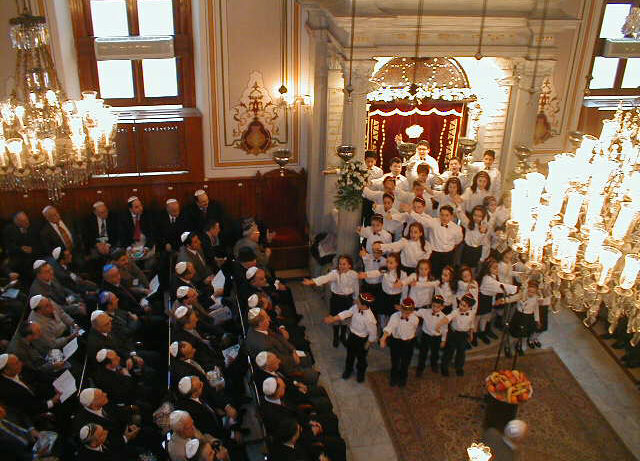 The Jews of Istanbul
The Jews of Istanbul
When I heard about the terrorist attacks against two synagogues in Istanbul -- simultaneous car bombings that killed six Jews and seventeen Muslims -- I thought about what the Turkish-Jewish community must have been doing this month. I was there a year ago, working as a volunteer for the Jewish Agency, and I can remember a vibrant community abuzz with Chanukah preparations. Now I wonder what damage the bombs might have done.
I remember that at this time last year, twenty children practiced singing Jewish songs and choreographing the annual Chanukah children's pageant at the Caddebostan synagogue. The old Ladino song "Ocho Candelikas" was the most photogenic; all the children raised eight small fingers in the air to symbolize the eights nights of Chanukah. Two blocks away from the synagogue at the Guzteppe Jewish community center a disciplined group of Jewish Turkish teenagers relentlessly rehearsed folk-dancing routines to the beat of Israeli Mizrachi music for their annual Chanukah festival. Beforehand, the group leaders of Istanbul's various Jewish youth groups met to coordinate Holiday events and plan the season's activities. Indeed, the Jews of Istanbul were in a frenzy of activity. They were well organized and well led, and they were enthusiastic both for Judaism and Jewish communal events.
The Jewish community in Istanbul has lived with its Muslim neighbors in relative peace for the past 500 years. Descended in part from Spanish Jews who fled expulsions and the Inquisition, the Turkish-Jewish community currently numbers around 20,000. The majority lives in or around Istanbul. Izmir, with about 3,000 Jews, has the second largest community. It is a challenge to preserve one's Jewishness as a minority in any country, let alone a Muslim one. But the Istanbul Jewish community is (or was) thriving.
The sprawling city is divided by the Bosphorus Sea into two sections named for the continents they are on - Europe and Asia. The European side is older, more devoutly religious, and contains most of Istanbul's commerce and history. The Jewish community used to be centered on the European side, mainly in the neighborhood where Neve Shalom, Istanbul's largest and most famous synagogue, is located, and in a few other locations. There used to be a small Jewish school near the synagogue before it moved to its larger, more modern campus in Ulus, a posh suburb north of the old neighborhood. Now most of the Jewish community lives in the nicer neighborhood near the school or on the Asian side, which, having been developed more recently, is more modern and less traditional than the European side. On the Asian side it is not unusual to see cafes open and operating during Ramadan, and the muezzin's call to prayer is less prevalent.
On the European side, down the street from historic Galata Tower, amidst densely packed electronics shops and classic Ottoman houses slowly undergoing gentrification, Neve Shalom is hard to find. When visitors to Istanbul's Jewish Museum ask for information about Jewish institutions in the city they are given a handsome pamphlet with very little information in it; only the names of synagogues and their phone numbers are provided -- all visits are made through appointments only. Despite the fact that the Jews no longer live close to it, Neve Shalom maintains its status as the largest and most famous synagogue in the city, often tightly booked on weekends with weddings, bar-mitzvahs, or community functions. The Shishli synagogue, beautiful on the inside, is accessible through a nondescript door next to textile stores on a stretch of Istanbul's shopping district. It is more a local synagogue with many community members living within walking distance and populating its three Shabbat morning services.
It was remarkable to me how active the Turkish-Jewish community has been without seeming to draw attention to itself. Well-organized youth groups meet twice each week to study Hebrew and Jewish tradition; there is a Jewish community center, upscale kosher restaurants, a Jewish museum, and a Jewish private school. For every Jewish holiday there are musical productions or festivals starring the community children, as well as at least three large community-wide and well-attended events either involving children's productions or community gatherings of some sort. On Tu B'Shvat alone I attended five family seders and three community-wide well-attended children's pageants replete with bow-tied choirboys and kindergartners dressed as fruit. Every Sunday a Zionist-oriented youth group practices Israeli folk-dancing; two members travel to a Jewish folk-dancing camp each year to train.



Harvard Death Fugue
On the Exploitation of Bruno Schulz
James Russell
The Jews of Istanbul
Sara Liss
The Truth about the Rosenbergs
Joel Stanley
Thinking despite Doubt, Feeling despite Truth
Jay Michaelson
Two Rituals
Joshua Bolton
Hepster Advice
Jennifer Blowdryer
Josh Goes to the Hospital
Josh Ring
Archive
Our 400 Back Pages
Saddies
David Stromberg
Zeek in Print
Winter 03 issue now on sale
About Zeek
Events
Contact Us
Links
From previous issues:
Strasbourg Cathedral
Michael Shurkin
Holocaust Video Testimonies
Dan Friedman
The Red-Green Alliance
Dave Hyde